This is one of the pines I started from seed in 1994. Most of these trees were grown as exposed root style, but a few ended up more conventionally shaped. A few years ago I cut it back to one branch and one bud – these remaining shoots have developed quickly.
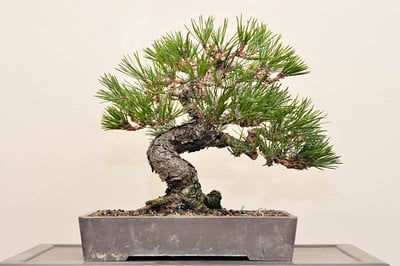
Front
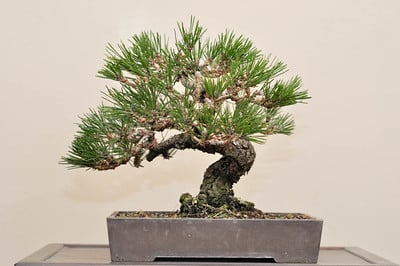
Back
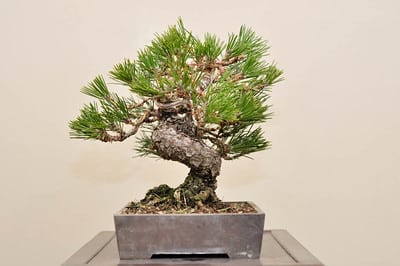
Left
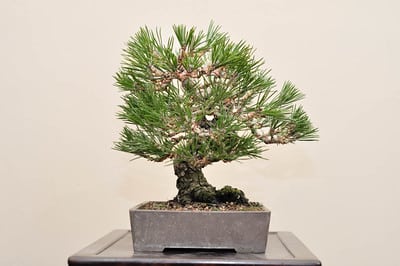
Right
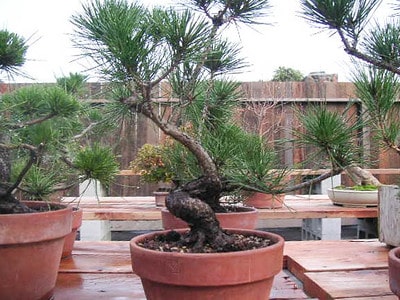
A few years back: taken 1/1/2003
Subscribe to Bonsai Tonight
New Posts Delivered Every Tuesday and Friday
crataegus says
The best blog name in bonsai, hats off to you Jonas…and we all wish we had started pine seeds over a decade ago to have some with the promise of yours. Bonsai today…bonsai tonight…bonsai yesterday…what more? bonsai ashita (bonsai tomorrow)—
Best,
Michael
Josef says
Hi Jonas,
After starting these trees from seed, where/how were they grown? In the ground, in large pots? A combination? I am at a bit of a loss as to when the transition growing methods and locations when growing on a young tree. Mostly I am interested in the propagation of deciduous material, however. Any advice you could offer would be most appreciated. Thanks!
xwires says
Hi Josef,
These pines have been container grown from seedling-cuttings for the entire 15 years. For smaller trees, container growing can yield nice bonsai. For larger trees, growing in the ground is useful to thicken the trunk more quickly. When you move from container to ground or back again isn’t as important as knowing what your goals are for the tree at any stage of development. If the trunk needs to get bigger fast, the ground is a good bet. If more refinement is needed, containers are the only option. I’ll be writing a lot more on the topic as time goes by as I have plenty of young pines in development – most in containers and one larger tree that started with 10 years in the ground before the refinement began.
Jonas
Josef says
Hi Jonas,
Thanks for the helpful reply. I hope you won’t mind a couple more questions. I see lots of pre-bonsai in terracotta pots in the images from Japan, and it looks like you are a fan of them too. Do you think that they are the best type of training pots? Also, most I’ve seen only have 1 drainage hole, so how do you prefer to secure the trees? Like a cascade pot? Thanks again for this wonderful blog and your help.
Josef
xwires says
Hi Josef,
I am a fan – terra cotta pots are great because they are porous and because they are inexpensive. Plastic containers don’t encourage new roots like terra cotta, and bonsai training pots are more expensive. Training pots are great when trees move from trunk or branch development to more refined development – many of my trees are in “training pots” or similarly inexpensive bonsai pots.
As for the drainage hole – you’re right, one hole is rarely enough. I drill all of my terra cotta pots to provide holes for securing the trees. Usually I add 4 small holes, big enough to let wire through and help with the drainage. Sometimes I widen the main drainage hole at the same time. A “hole saw” (drill-bit used for making large holes) is great for this task.
One note about terra cotta pots. The most commonly found terra cotta pots available in nurseries are usually unnecessarily deep for bonsai. I tend towards the more shallow pots to encourage the lateral roots.
Thanks for the questions,
Jonas
Josef says
Thanks for the quick and informative reply, Jonas. You have been of great help to me. I have one last question for you! I have also noticed many folks using colanders to grow out shohin JBP stock, and have seen the method detailed in Stone Lantern’s pine book. Do you see any major differences between the colanders and terracotta, or unique capabilities making one or the other superior?
Best Regards,
Josef
xwires says
I too use colanders and believe they work well. They are good for producing many fine roots in a compact container. Large terra cotta pots encourage larger roots and vigorous growth – they are a step closer to letting a tree develop in the ground. Depending on your goals either can work well. I always keep a number of my young trees in colanders but haven’t found a significant enough difference in growth rates to warrant a switch to all one container or the other.
That said, growing pines in colanders requires a lot of water as they dry out more quickly than pines in terra cotta pots. Your choice may depend on hot it gets where you live and how much you can water.
Josef says
Thanks so much Jonas!!!
Sam Edge says
You might refer to Bonsai Today number 20 I believe as it has an article on how to accelerate the growth of black pines from seed using colanders.
Having used this approach over five years and with some trunks now approaching 1.5 inches in size or more, the approach does work very well.
The colander also allows lots of air in for the roots and using Boon’s soil (akadama, pumice, and lava) with lots of fertilizer increases the girth very quickly.
Nice trees Jonas.